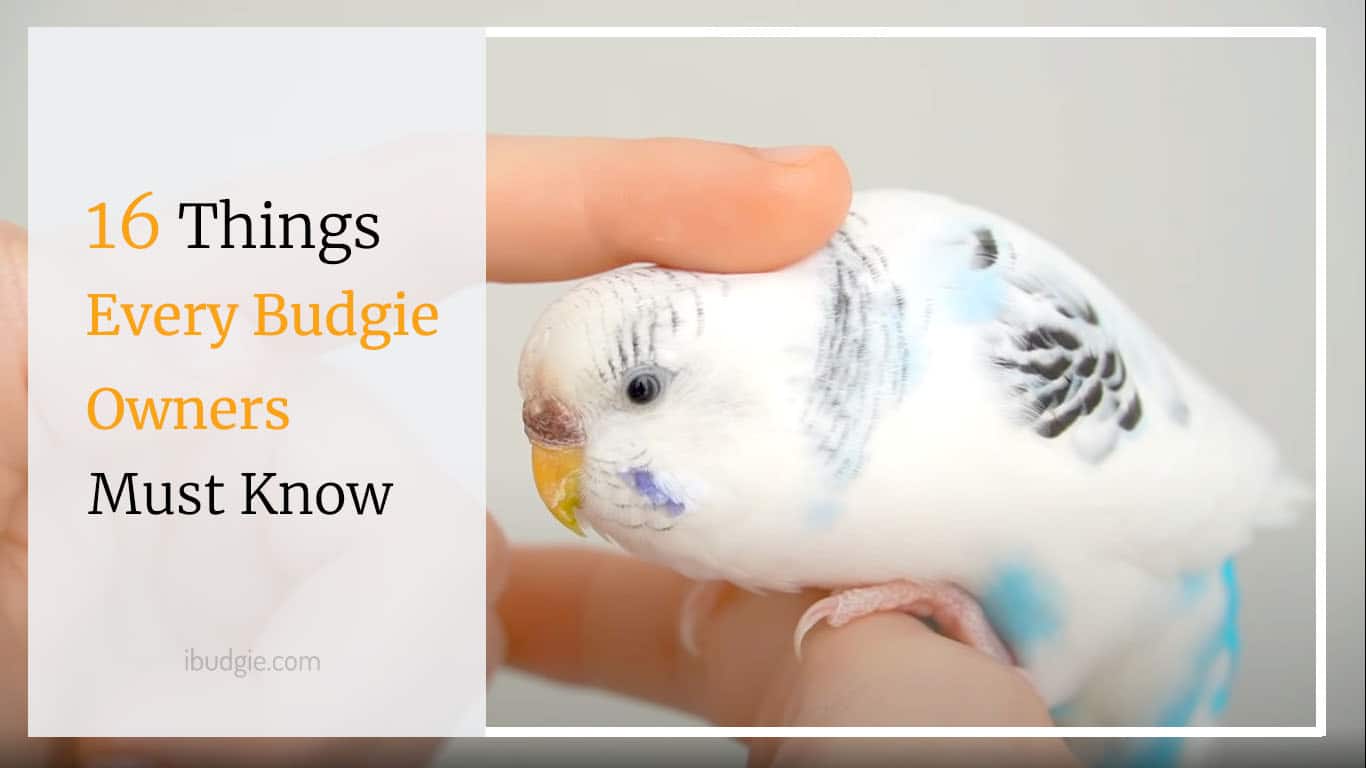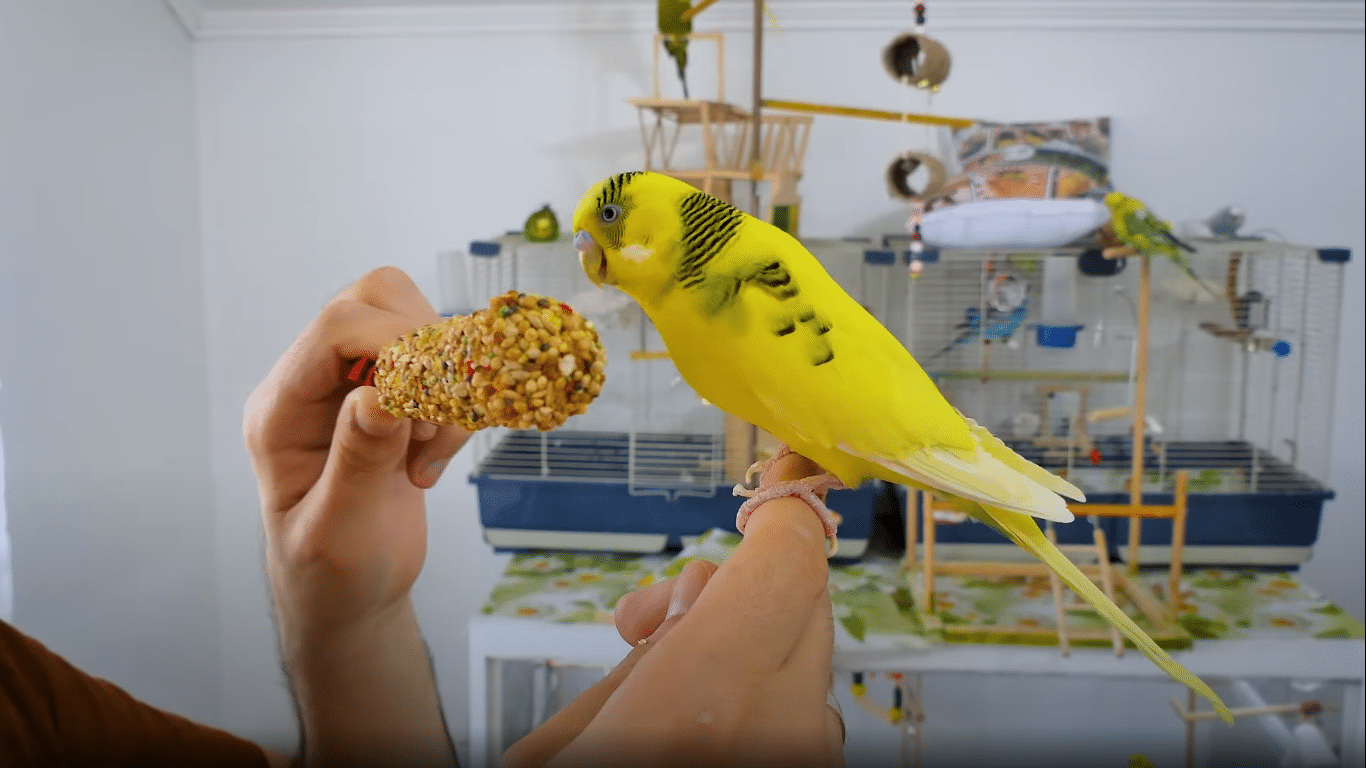Budgies are the most popular type of pet birds. In fact, 45% of the pet birds in United State are budgies. They are more commonly known as parakeets or budgerigar. Budgies are the best starter birds for new pet bird owners and anyone who would like to have a feathered friend. In this blog reading, you will find out 16 most asked things every budgie owner must know.

As single bird, budgie makes good companions and enjoy interacting with their owner. Anyone who is willing to learn about these beautiful birds and their care should be able to bring one home and have several years of companionship with their new pet.
Table of Contents
General facts about Budgies
Budgies have two toes that face forward and two that face backward on each foot. Gender can be easily determined by looking at an adult budgie’s cere. Male budgie have blue cere in most cases whereas female have brown cere. As a pet bird, budgies are bread in various color mutation, but the only natural color is Green.
There are two breeds of budgies, the English budgie, usually quite bigger than the Australian budgie. Budgies are flock birds and must be socialized daily. Experts recommend having more than one budgie to ensure they have the company they need to thrive. If you want to tame your budgie than the recommendation is to pet single male budgie. With proper care and diet, a pet budgie can live 12-15 years and sometimes more.
Many newbie budgie owners as well the budgie parents who are petting budgies since years ask me about budgie care, diet, cage setup and more.
Here are 16 things every budgie owner must know
Should I get one or two budgies?
Budgies in the wild are flock birds and feel safer in groups. But if you are home a lot and want to bond closely with budgie. Then it’s easy to do so with one. Recommendation is to start with one is fine and use your judgement to let you know if your new feather friend is lonely or scared.
How to tell if a budgie is male or female?
The best way to tell the sex of budgie is its cera above the beak. In mature budgies, a female will have chalk white, pale blue or tan dark brown cera depending on breeding conditions. Males will have solid pink or very dark vibrant cere. Some variation can be found on this based on coloring and juvenile budgies are different as well. The important thing is to do your own research instead of listening to pet store employees. They are frequently either totally innocent informed or may want you to believe the budgie in question is the boy which is frequently preferred sex for pet budgie.
Read in-depth article on budgies gender identification.
How can you tell if a budgie is young?
Young budgie generally has bars down the top of its head and meets up with the tip of it’s cere. These lines are referred to as “baby bars”. Baby budgies also have fully black eyes with no sign of an iris. With a standard blue or green budgie they are very reliable markers but this can vary by color mutation.
What gear does a budgie need?
A budgie needs lots of stuff for basic health as well as for engagement. Some basics are cage, food and water bowl, variety of perches, toys etc.
What size cage does a budgie require?
My recommendation is to get the largest cage you can afford based on budget, space. But keep in mind that the most budgies prefer a cage that’s longer than it’s tall because of the way they fly. Also bars spacing of 1 half inch is vital. Anything larger, you will risk the budgie escape or injury. A cage size of 20 inches long, 18 inches deep and 18 inches wide is the minimum for a one budgie while a pair should have no less than 30 inches long, but the equal depth and height.
How long do budgies live?
A. Budgies can live anywhere from 2 to 15 years depending on diet and quality of care. An honest average is 6 years. Many budgies also die prematurely in home accidents such as attack by other household pets and injury from common dangers such as windows, mirrors and pet animals.
What should I put on the bottom of my bird cage?
Are newspaper shreds good enough? Many budgie parents use newspapers, paper towels or craft paper at the bottom of the cage. I personally think all of those options are good as they permit you to watch the standard of your budgie’s poop. Cut-to-size liners are totally a convenience item versus a necessity but it makes our lives easier.
Will my budgie learn to talk?
Maybe, although generally not without tons of effort on your part. Also males are more likely to speak than female budgies. Anecdotal evidence suggests that it’s easier to show one budgie to speak instead of a pair or more.
How much sleep do budgies need?
Budgies need 10-12 hours of sleep per night. Some can get by on less by supplementing with naps during the day, but they really should have a minimum of 10 hours of dark per night.
Read in-depth article about budgies sleeping positions also find out why they don’t fall off while sleeping.
What is the best temperature a house should have for budgies?
Budgies will typically adjust pretty much to a good range of temperatures. Budgies that sleep in outdoor areas can even tolerate temperatures within the 40 degree Fahrenheit range as long as there’s a source of warmth and that they aren’t exposed to wind. Within the home, a suggested range would be 68-78 degrees Fahrenheit to make sure they’re not too cold or too hot.
What is the best diet for a budgie?

Pellets are developed to satisfy all of your bird’s nutritional needs. Hand-raised babies should be started on pelleted diets. It’s going to be difficult to convert mature budgies to pelleted diets. Different formulations are available for various life stages and for the management of certain diseases. Pellets are the perfect diet; therefore, seed-eating birds should be slowly weaned off seeds onto a pelleted diet. Pellets should represent approximately 75-80% of the budgie’s diet. Along with the pelleted diet, budgies should also be offered with green vegetables and fruits. Fruits, vegetables, and greens should account no more than 20 – 25% of the daily diet.
People also read: Can parakeets eat bananas?
Should I clip my budgies wings?
Budgies are born to fly and should be able to have free flight in the home for at least 2 hours per day. Every budgie owner’s first attempt should be building a totally bird-proof home and taking tons of attention for their safety. If your circumstances differ, you might consider either leaving your bird to a single room for free flight or clipping them. Many budgie owners report that it is easier to tame a clipped budgie and then let the wings grow out.
Clipping is not basically a permanent situation, the clipped feathers will fall out upon molting and grow back restoring full flight. If you still want to clip, we do recommend that clipping be done by a professional, or at the very least that you learn how to clip your budgie from a professional before attempting at home.
My budgie never drinks, is he okay?
A. Budgies are prey birds by nature and drinking puts them in a very vulnerable position. Until the budgie feels totally comfortable in your home you probably will not see him drinking. Instead he will wait until he’s alone and feels safe to drink water. Access to clean water is very much important to bird health. Budgie’s water should be changed daily and it’s vitally important that you do not give them distilled water.
My budgie won’t bathe, what do I do?
A. Budgies can bathe in many different ways. It’s not important that all budgies take a single kind of bath. Perseverance is the key, and you can always resort to lightly misting them if they are seriously water averse.
My budgie is losing feathers, what’s happening?
Here we need to understand the molting process, which is a very normal process. A budgie sheds old feathers and replaces them with new. Molting occurs twice a year or more and can be triggered by changing seasons. Unless your budgie has a feather disorder , he is molting which as mentioned is natural and needs no worries.
What are best perches for budgies, plastics or wooden perches?
A. Wooden Perches are more recommended than plastics perches. Perches with varying width and thickness of natural wood encourage foot health. We don’t recommend keeping any of those plastic perches as long as wooden perches are available.
